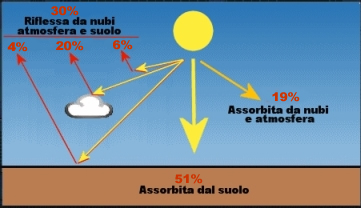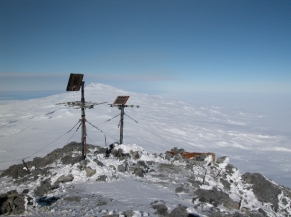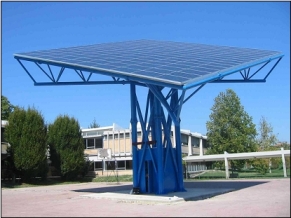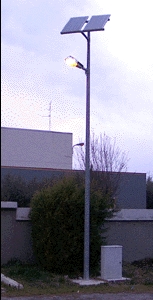Solar energy
 Fig. 1: Classification of solar energy. Only slightly over 50% of radiation coming from the sun reaches the earth’s surface . (direct radiation) Credit: (Meteo Ostia) |
Solar
energy![]() reaches
everywhere, it costs nothing and it is
renewable
reaches
everywhere, it costs nothing and it is
renewable ![]() .
However, it is very diluted in space and it is not continuous - it varies with the
alternating of day and night, the different seasons and various weather
conditions.
.
However, it is very diluted in space and it is not continuous - it varies with the
alternating of day and night, the different seasons and various weather
conditions.
Not all the energy radiated by the Sun
reaches the surface of the Earth: some of it is reflected back into space, some is
dispersed and diffused in all directions by air molecules and dust particles in the
atmosphere, and some is absorbed by water vapour, by carbon
dioxide![]() and
by the
ozone
and
by the
ozone![]() in the atmosphere (Fig. 1).
in the atmosphere (Fig. 1).
 |
|
|
 |
||
| Fig. 2: Examples of applications of solar panels. | ||
The simplest and most promising use
of solar radiation in energy terms is that of solar panels, both for heating and for
the direct production of electric
energy![]() .
On a small and medium scale, both have a limited impact on the environment compared to
fossil
fuels
.
On a small and medium scale, both have a limited impact on the environment compared to
fossil
fuels![]() .
.
At present
there is an enormous number of applications with small
photovoltaic
devices![]() . For example, they are used
for calculators and wrist watches; bigger panels are used to provide electricity for
domestic use, to pump water out of the ground, to supply power to telecommunications
systems, for emergency use, etc.
. For example, they are used
for calculators and wrist watches; bigger panels are used to provide electricity for
domestic use, to pump water out of the ground, to supply power to telecommunications
systems, for emergency use, etc.
It is worth noting that other renewable sources of energy,
such as
hydroelectric![]() ,
wind
,
wind![]() and
biomass
and
biomass![]() power stations are all traced back to solar energy.
power stations are all traced back to solar energy.
Solar energy produces heat which can be exploited in many practical applications: flat panels for producing hot water, heating greenhouses, etc.
Fig. 2 shows some applications of
photovoltaic solar panels - used for weather applications (top left), to
supply a building with electric energy (bottom left) and for public lighting (right), using
batteries![]() which are recharged during the day.
which are recharged during the day.
Apart from the normal photovoltaic systems,
there are also
thermoelectric solar systems![]() made up of panels (mirrors) which "follow" the sun to obtain maximum efficiency, and produce heat and/or energy. In a
solar tower
made up of panels (mirrors) which "follow" the sun to obtain maximum efficiency, and produce heat and/or energy. In a
solar tower![]() the panels/mirrors concentrate light from the sun on a
"boiler" placed at the top of the tower.
By means of a special system and movement of the panels,
the boiler can reach very high temperatures.
the panels/mirrors concentrate light from the sun on a
"boiler" placed at the top of the tower.
By means of a special system and movement of the panels,
the boiler can reach very high temperatures.
In many countries, numerous programmes and various incentives have been approved with regard to the direct use of solar energy with flat photovoltaic panels: Germany has a "100000 solar roofs" programme and in Italy, as already mentioned, ENEA is running a similar project. The United States of America has a programme for one million solar roofs, in part thermal solar, and Japan has a similar programme. The European Community also has a similar programme which includes aid for developing countries.
